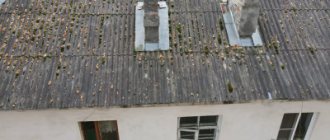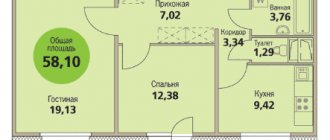During the implementation of this program, the serious word “renovation” managed to acquire speculation. Some Muscovites are looking forward to this event, while others, on the contrary, are worried that the capital’s authorities will take away their usual habitable housing and forcibly relocate them to apartments, houses or areas that leave much to be desired. Let's take a closer look at what renovation is in simple words?
Renovation is the replacement of old buildings: five-story buildings, 3- and 4-story residential buildings, as well as two-story buildings with communal apartments with modern new buildings.
Renovation in Moscow
The housing renovation program means relocating residents of old houses, in most cases “Khrushchev” buildings, but also houses of the “Stalin” period, built into new types of apartment buildings. Renovation involves ridding the city of old buildings and changing the infrastructure of entire areas. The authorities promise that apartments in new buildings will be provided in the same area where people lived until now. Old houses will be demolished in order to build new residential buildings and complexes in their place.
In simple words, renovation is the demolition of old low-rise apartment buildings and the construction in their place of new modern high-rise buildings that meet modern standards and living standards.
Renovation in Russia
This program of renovation and replacement of outdated residential apartment buildings works not only in Moscow. Renovation is also taking place in St. Petersburg, but the program is called “Development of Built-Up Areas in St. Petersburg” (RZT). Also, the renovation program is being discussed in other cities and it is likely that it will be implemented throughout Russia in the near future.
New buildings for renovation in St. Petersburg
Technologies
Technological progress today makes it possible to carry out updates and transformations that were almost impossible to implement just a few years ago.
Selection and cleaning methods, as well as primary diagnostics, already make it possible to reasonably guarantee the health of workers and future residents, if necessary, removing harmful products that may be in buildings.
On the other hand, eco-materials allow the use of less toxic substances than before.
And advances in computer technology make it possible to visualize plans in three dimensions and evaluate the strength of a beam, wall or column. For example, in order to determine priorities and necessary work. Infrared diagnostics can detect actual or potential heat leaks. Energy diagnostics evaluate possible energy savings.
It would seem that the best results are achieved with a global approach, when experts in renewing energy resources are used. But existing models take little into account parameters related to the use and purpose of the building, or the thermal inertia of materials, or hygrometric behavior. On the other hand, it is also fair to recognize that the level of expert knowledge and their capabilities are rapidly evolving.
Demolition programs
It is worth paying attention to the fact that “Renovation” and the “Program for relocation from dilapidated housing”, which operate simultaneously not only in Moscow, the Moscow region and other areas, are not the same thing. If the commission recognizes the house as unsafe, then residents will be offered the only option for relocation. This option is most often a new building. In another case, financial compensation will be provided, but the house will be demolished. Since not all five-story buildings in disrepair have the technical ability to make major repairs, and more often this is not financially feasible for local authorities.
A look into history
The first round of the five-story building renovation program started under Moscow Mayor Luzhkov in the late 90s of the last century. At that time, both the authorities and Muscovites put a completely different meaning into the word “renovation”. As Luzhkov himself noted, during the renovation according to his project, not a single protest arose among the residents of the capital, and here’s why.
Renovation of Luzhkov
According to Luzhkov’s project, the renovation program included only emergency panel “Khrushchev” buildings of only certain series of houses that could not be repaired and in which it was dangerous to live. A series of standard buildings in need of resettlement were identified. If the house corresponded to the series, it was additionally inspected on the technical side, looking at the condition of the housing. If the emergency situation was obvious, the house was included in the renovation.
Luzhkov's renovation program made it possible to obtain housing in the same microdistrict as the old one. And in terms of cost, an apartment in a new building was definitely more expensive than one in an emergency building at the beginning of industrial development. The owner could refuse the option offered to him and demand to see another that would be more suitable to his requirements. Until a person makes up his mind, he is not evicted.
There was also the concept of a social norm - in simple words, if there are less than 18 square meters per person in a family, a more spacious apartment is provided.
Sobyanin's renovation
The new renovation according to Sobyanin is relocation according to zones. And in the zone there may be either an emergency destroyed Khrushchev building or a good Stalin building with three-meter ceilings and large rooms. Under the new renovation, both will be demolished, but in which case - we’ll say further.
Today, Muscovites are given the opportunity to choose an apartment in a building built specifically for relocation, but in fact without the right of refusal. Whether this will be equivalent housing is a big question. After all, it has been proposed to resettle not only unsafe five-story buildings on the outskirts of the city, but also good-quality “Stalin” buildings in the center of Moscow.
Legal nuances
From a legal point of view, the difference is also significant. Under Luzhkov, the owner first received the rights to new housing, and then abandoned the old one. Today, first, the transfer of the apartment to the Foundation is formalized, and the person receives a written guarantee from the Moscow Government about the provision of housing. The risk of becoming homeless theoretically remains.
In general, the renovation program under Luzhkov was more focused on improving the standard of living of Muscovites living in dilapidated buildings. As a result, more than 1,700 houses were resettled in almost 20 years without protests. The main goal of Sobyanin’s program is to improve the appearance of the capital, so ordinary people are given much fewer guarantees.
What else are they trying to renovate?
Already in March, Russian-language media and officials began using the word “renovation” without mentioning the Moscow program to demolish five-story buildings and often ignoring the original meaning of the word.
“Kommersant” collected the most illustrative examples:
“The director believes that in the renovation of the play
It is the talented youth of the NOVAT opera troupe that will give the opera, staged in 1997, a charge of novelty”
(on the website of the Novosibirsk State Academic Opera and Ballet Theater)
.
The AppStore application store has also undergone a complete renovation.
(“Kommersant FM”).
“Over the past decades, we have seen an impressive renovation of the images of many historical figures
, starting with Vladimir the Baptist (who, frankly speaking, has a very indirect relation to modern Russia) right up to Kolchak”
(Pravaya.Ru).
of renovating the World Hockey Championship, which is considered progressive
Like it happens too often, the best don’t always come there, the Americans bring schoolchildren, the competition is minimal, the status of the champion is devalued”
(Eurosport.ru).
Activation and renovation of interparliamentary cooperation in modern conditions is timely and expected
(Chairman of the Parliament of Kabardino-Balkaria Tatyana Egorova in a press service message).
“It was a decline that should have led to either a refusal to continue practicing Muay Thai, or to a renovation of both the training process and my psychological state
»
(World champion in Thai boxing among amateurs according to IFMA Valeria Drozdova in an interview with Soviet Sport).
New wave of renovation
Since 2021, they have started talking about renovation again, but now the draft program is so confusing that Muscovites are trying to find explanations in simple words. However, even after several years, changes, additions and reservations are made to the renovation, which means that there are still many unresolved issues in the program.
The main points of the modern renovation program in simple words:
- The houses included in the program are not necessarily in disrepair. However, authorities assure that their service life is coming to an end and they will still need to be demolished.
- Muscovites are provided with equivalent housing – in terms of area, number of rooms and area. The corridors, kitchens and bathrooms in the new apartments will be more spacious than in the Khrushchev-era buildings. It is assumed that the new living space will definitely be better than the old one, but it is difficult to say that new and old housing are of equal value.
- If a person on the waiting list is resettled under the renovation program, he is provided with an apartment with simultaneous improvement of living conditions.
- The infrastructure of districts and local areas will also not be left behind. In each renovated area, the construction of hospitals, schools is planned, children's and sports grounds, and social facilities are designed. In the houses themselves, a special non-residential area is allocated on the ground floor for institutions, shops, and pharmacies. Not just new buildings will appear, but entire residential complexes in microdistricts.
As in Luzhkov’s program, and in the current one, residents receive housing with a fully clean finish, with connected communications, electricity and installed plumbing without additional payments.
Wednesday
The legislation on renovation clearly states that both damage to the entire building, as well as the wear and tear of residential premises and their footage must be taken into account. It is imperative to preserve the entire infrastructure of the entire territory.
This is especially true for all domestic and social establishments. This is a convenient location for schools and kindergartens, hospitals, pharmacies and shops.
Availability and modern equipment of sports and children's playgrounds. Public availability of engineering structure. And if these objects require demolition, then renovation will be carried out on them as well.
Residents vote on renovation
Initially, almost 8,000 houses were included in the list for demolition, but later the list was reduced to 5,000 - based on the results of a vote by Muscovites. Residents of houses included in the program were required to vote on the issue of resettlement. If the number of renovation supporters in a building was equal to 2/3 of the number of apartments in the building or more, the house was added to the list of houses for demolition. Voting was carried out electronically through the “Active Citizen” service or in person through “My Documents” in the spring-summer of 2021.
The voices said:
- First, we determined how each apartment voted. If there was only one owner, only his opinion was considered; if there were several, everything was determined by a simple majority of votes. If they voted equally, then the apartment’s opinion was not taken into account at all.
- Next, they collected all the votes from all the apartments and thus determined the position of the entire house as a whole.
The votes of those who did not take part were not written off, but were taken into account in proportion to the results of active apartments. For example, if 80% of those who voted were for and 20% were against the program, then the remaining votes were distributed in the same proportion 80/20.
By the way, the votes passed a three-stage verification using the SNILS number or passport data.
Opting out
If the house is given for renovation, and the residents are categorically against this , they have the right to appeal such a decision.
In the city districts there are special commissions, which consist of investors and government representatives. Some apartment owners are worried that they could be evicted without warning.
In fact the situation looks like this:
- eviction can only be carried out after receiving the written consent of the person who owns the apartment;
- the decision is made during a meeting attended by residents;
- if the house is not in disrepair, the issue is considered during planning.
If a person is against the renovation of the building in which his apartment is located, he has the right to contact representatives of the commission. To do this, you need to bring an application in writing or send it through the State Services portal.
The document indicates the date, passport details, type, square footage of the apartment and specific address, and describes the reasons why the tenant does not agree to participate in the program. The application is considered at a scheduled meeting of the commission of a certain district.
Launch pads
The construction of houses for the first wave of resettlement of Muscovites began at the launch sites. What does "launching pad" mean? This means that a high-rise building will be built on the allocated territory, into which residents of nearby houses in the block or area will move. Then the evicted houses will be demolished, and new housing will be built in their place, where participants in the second wave of resettlement will move in.
Today, work is underway at more than 350 launch sites under the renovation program. Their list is constantly updated, and a map of future new buildings is posted on the Moscow Mayor’s website.
Launch sites are determined by local authorities, and in some cases they are proposed by Muscovites themselves. For example, residents of the Ostankino district took the initiative to include the site on the street in the list of launching sites. Godovikova 10. In April 2021, this site was included in the list.
Renovation Fund
In simple words, this is an official institution through which all procedures for transferring rights to real estate take place. The Fund accumulates money, which is then spent on the implementation of the renovation program.
The Foundation organized the work of its information centers so that Muscovites could resolve their issues as quickly as possible. The information centers receive specialists on key points:
- development of the renovation program as a whole, exchange of information between participants;
- organization of relocation according to requests;
- consultations on the equivalence of premises;
- conclusion of contracts, transfer of rights and certification of additional guarantees;
- purchasing additional meters for an additional fee;
- resolution of conflicts and various social issues;
- consultations on technical characteristics, housing defects, and other construction issues;
- showing apartments and issuing keys.
The Renovation Fund was established by the Moscow Government represented by the Construction Department. This means that the Fund is a completely budgetary structure that is subordinate only to the capital’s authorities.
Renovation headquarters
On the side of the residents is the Public Headquarters for Control over Renovation. The documents show that the headquarters:
- in 2021, checked the voting results for legality and correctness;
- supports Muscovites in communicating with authorities - councils and prefectures;
- clarifies the law on various issues, especially the voting procedure;
- conducts public meetings and hearings;
- checks the correctness of the allocation of launch sites;
- carries out public control over renovation in various ways.
A public reception has been organized at the Headquarters, where you can contact with any problem or question regarding renovation.
Restoration work
Restoration in the world of architecture is a controversial topic, debated for centuries. In this case, restoration by law means a set of measures whose purpose is to ensure the material integrity of the architectural heritage and preserve its cultural values.
When carrying out restoration work, in addition to maintenance, it is possible to partially or completely change the purpose of the building.
Various permits may be required for restoration work.
Developers
Construction as part of the Moscow renovation is provided by a number of developers, including:
- Department of Civil Engineering;
- Management of experimental development of microdistricts;
- "KPOCT";
- FCK "Leader";
- LCP Group;
- GC "PIK";
- "Inteko";
- GBSU.
The issue of attracting new developers is being discussed in the TiNAO district.
Determining who exactly will build a particular house is the task of the Renovation Fund. The competition between companies is carried out according to government procurement rules. Tenders usually involve from 2 to 6 companies that offer their own conditions based on available opportunities.
The construction of each house is carried out according to a project approved by the Moscow Government. Developers emphasize that the projects are individual, the layouts are completely different, but they are all created taking into account the needs of moving families.
Developers (aka construction companies or developers) undertake to deliver apartments that comply with the project, are suitable for living, and are fully equipped. If defects are identified, you need to contact the management company and document the deficiencies in a document so that they can be eliminated as soon as possible.









